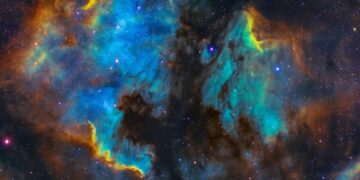For centuries, the origins of the universe have been one of humanity’s greatest mysteries. The dominant Big Bang theory suggests that our universe emerged from an infinitely dense singularity, an idea that has raised as many questions as it has answered. But what if our universe didn’t begin from a singularity? What if, instead, it emerged smoothly from a quantum process—alongside a mirror-image anti-universe that flows backward in time.
The Quest for Cosmic Origins
For decades, cosmologists have sought to explain how the universe began. The Big Bang theory is the most widely accepted model, but it comes with an inherent problem: the singularity paradox. The idea that the universe originated from an infinitely small and dense point contradicts our understanding of physics, as singularities defy conventional mathematical descriptions.
Several alternative models have been proposed to resolve this issue:
- The Hartle–Hawking no-boundary proposal suggests that the universe emerged from a smooth, compact geometry rather than a singularity, but it struggles to explain the required rapid inflationary period.
- The Vilenkin tunneling model proposes that the universe “tunneled” into existence, but it has difficulty in predicting the correct cosmic fluctuations.
Kumar’s approach offers a new perspective—one that eliminates the singularity while explaining why our universe appears flat and why it behaves the way it does.
Quantum Creation: A New Paradigm
One of the most fascinating aspects of Kumar’s model is that it treats the creation of the universe as a quantum event. According to quantum mechanics, particles can appear and disappear spontaneously due to quantum fluctuations. If this phenomenon applies at a cosmic scale, entire universes could emerge from quantum processes—eliminating the need for a singularity.
Kumar suggests that our universe did not appear alone but rather as part of a universe-anti-universe pair, both emerging from a Euclidean space where time behaves more like a spatial dimension. This means:
- Our universe moves forward in time, evolving into the cosmos we see today.
- The anti-universe moves backward in time, existing as a mirror image of our own universe but in reverse.
This idea introduces the concept of a quantum genesis, where the universe and its anti-universe originate from nothing, following well-defined quantum principles.
CPT Symmetry: The Universe’s Mirror Image
A major pillar of this theory is CPT symmetry, one of the fundamental principles in physics. CPT stands for:
- Charge (C): Swapping particles with their antiparticles.
- Parity (P): Flipping spatial coordinates, like looking at the universe in a mirror.
- Time (T): Reversing the direction of time’s flow.
According to physics, the laws of nature should remain unchanged under CPT transformations. Kumar’s model applies this concept on a cosmic scale, proposing that when our universe formed, an anti-universe with opposite charge, mirrored parity, and reversed time also formed.
Quantum Potential and Cosmic Flatness
One of the most intriguing observations in cosmology is that the universe is nearly flat. This means that the curvature of space is incredibly close to zero (k = 0). Traditional models struggle to explain why the universe would naturally evolve into such a precise state.
Kumar’s model introduces a quantum potential, an additional component of the universe’s wavefunction that mimics the effects of spatial curvature. Instead of needing a specific initial condition to enforce flatness, this quantum potential automatically drives the universe toward flatness, making it a natural outcome rather than an arbitrary assumption.
This quantum potential could provide answers to:
- Why our universe is flat despite initial conditions allowing for other possibilities.
- Why cosmic inflation occurred and how the universe expanded so rapidly in its early moments.
Implications for Dark Matter and Dark Energy
Perhaps one of the most exciting aspects of this model is its potential to explain dark matter and dark energy—two of the biggest unsolved mysteries in cosmology.
- Dark Matter: The entanglement between our universe and its anti-universe may manifest as the effects we attribute to dark matter. If particles in our universe interact with their counterparts in the anti-universe, they could create an unseen gravitational influence that mimics dark matter’s effects.
- Dark Energy: The presence of an anti-universe could also explain why our universe is expanding at an accelerating rate. If the two universes exert quantum influences on each other, it could manifest as the repulsive force we call dark energy.
This model could provide a unified explanation for phenomena that have puzzled physicists for decades.
Challenging Conventional Wisdom
Kumar’s work builds on earlier cosmological models but also challenges them in significant ways. Unlike previous proposals:
- It avoids the singularity problem altogether.
- It naturally predicts inflation, solving the “horizon problem” without extra assumptions.
- It provides a potential explanation for dark matter and dark energy that ties back to the universe’s fundamental symmetries.
This holistic approach positions Kumar’s model as a leading alternative in the quest to understand the universe’s origins.
Observational Signatures and Future Research
For any theory to gain acceptance, it must be testable. Kumar’s model predicts certain observational signatures that scientists could search for in existing and future datasets.
Potential tests include:
- Cosmic Microwave Background (CMB) fluctuations: If the universe-anti-universe model is correct, subtle imprints in the CMB could reveal unique symmetry patterns.
- Gravitational wave signatures: The formation of a universe-anti-universe pair may produce detectable gravitational waves.
- Large-scale structure analysis: The way galaxies are distributed across the universe could provide clues about quantum potential effects.
Future research will focus on refining these predictions and designing experiments that could confirm—or challenge—this groundbreaking idea.
Conclusion
Naman Kumar’s quantum genesis model provides a bold, elegant, and scientifically grounded alternative to the traditional Big Bang singularity.
Reference:
Naman Kumar, Creation of a flat universe-antiuniverse pair from nothing, Europhysics Letters (2025). DOI: 10.1209/0295-5075/adb451



















